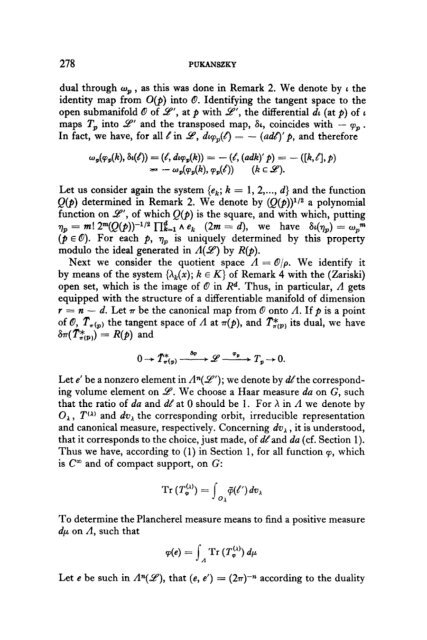On the Characters and the Plancherel Formula of Nilpotent Groups ...
On the Characters and the Plancherel Formula of Nilpotent Groups ...
On the Characters and the Plancherel Formula of Nilpotent Groups ...
Create successful ePaper yourself
Turn your PDF publications into a flip-book with our unique Google optimized e-Paper software.
278 PUKANSZKY<br />
dual through wz, , as this was done in Remark 2. We denote by L <strong>the</strong><br />
identity map from O(p) into 0. Identifying <strong>the</strong> tangent space to <strong>the</strong><br />
open submanifold 0 <strong>of</strong> $P’, at p with Y, <strong>the</strong> differential dL (at p) <strong>of</strong> L<br />
maps Tp into 9’ <strong>and</strong> <strong>the</strong> transposed map, &, coincides with - ?D .<br />
In fact, we have, for all tin 9, dcy#) = - (a&)‘p, <strong>and</strong> <strong>the</strong>refore<br />
4v,(k), W)) = (4 dv,,(k)) = - (4 Wk)’ P) = - ([k 4, P)<br />
= - 4dk)s vk9> (k E 3).<br />
Let us consider again <strong>the</strong> system {e,; K = 1, 2,..., d} <strong>and</strong> <strong>the</strong> function<br />
Q,(p) determined in Remark 2. We denote by (Q(p))1/2 a polynomial<br />
function on S’, <strong>of</strong> which Q(p) is <strong>the</strong> square, <strong>and</strong> with which, putting<br />
vp = m! 2”(Q&~))-l/~ nd- k-l A ek (2~2 = d), we have Sb(qJ = up”<br />
(p E 0). For each p, qp is uniquely determined by this property<br />
modulo <strong>the</strong> ideal generated in A(Y) by R(p).<br />
Next we consider <strong>the</strong> quotient space A = 8/p. We identify it<br />
by means <strong>of</strong> <strong>the</strong> system {AL(x); k E K} <strong>of</strong> Remark 4 with <strong>the</strong> (Zariski)<br />
open set, which is <strong>the</strong> image <strong>of</strong> 0 in Rd. Thus, in particular, A gets<br />
equipped with <strong>the</strong> structure <strong>of</strong> a differentiable manifold <strong>of</strong> dimension<br />
r = n - d. Let 71 be <strong>the</strong> canonical map from 0 onto A. If p is a point<br />
<strong>of</strong>@, t(p) <strong>the</strong> tangent space <strong>of</strong> A at n(p), <strong>and</strong> Tztpj its dual, we have<br />
&r(T&,) = R(p) <strong>and</strong><br />
Let e’ be a nonzero element in A”($“); we denote by ti<strong>the</strong> correspond-<br />
ing volume element on 9. We choose a Haar measure da on G, such<br />
that <strong>the</strong> ratio <strong>of</strong> da <strong>and</strong> dJ at 0 should be 1. For h in A we denote by<br />
OA , T’“) <strong>and</strong> dvA <strong>the</strong> corresponding orbit, irreducible representation<br />
<strong>and</strong> canonical measure, respectively. Concerning dvA , it is understood,<br />
that it corresponds to <strong>the</strong> choice, just made, <strong>of</strong> d/<strong>and</strong> da (cf. Section 1).<br />
Thus we have, according to (1) in Section 1, for all function F, which<br />
is C” <strong>and</strong> <strong>of</strong> compact support, on G:<br />
Tr (T$ = ~,,$5(&“) dv,<br />
To determine <strong>the</strong> <strong>Plancherel</strong> measure means to find a positive measure<br />
dp on A, such that<br />
Let e be such in Am(Y), that (e, e’) = (277)-n according to <strong>the</strong> duality

















